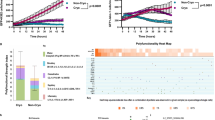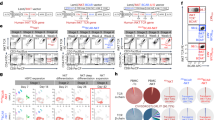Abstract
Among potential genetic targets for intervention in the HIV-1 life cycle, the tat gene product is a key target. We investigated the ability of an antitat gene to inhibit HIV-1 activation and replication in chronically infected promonocyte (U1) and T cell (ACH-2) lines in vitro. U1 and ACH-2 cells were transduced with an antitat gene expressing RNA with dual (polymeric Tat activation response element and antisense-tat) function that interferes with HIV-1 replication. Tumor necrosis factor-alpha (TNF-α) plus phorbol 12- myristate 13-acetate (PMA)-induced HIV-1 expression, as determined by reverse transcribed PCR and reverse transcriptase (RT) assays, was significantly inhibited in U1 and ACH-2 cells transduced with the antitat gene, compared with the cells transduced with control vector and untransduced cells. This resistance to TNF-α plus PMA-induced HIV-1 expression was demonstrated in antitat gene-transduced U1 and ACH-2 cells maintained in G418-free media for 5 months, suggesting that functional antitat gene may persist for many months in transduced cells and their progeny. Most importantly, we demonstrate that the antitat gene, when introduced into peripheral blood mononuclear cells (PBMC) isolated from patients with HIV-1 infection, inhibited TNF-α plus PMA-induced viral replication as determined by RT-PCR and RT activity. In addition, the antitat gene enhanced the survival of CD4+ T lymphocytes from such patients. These data suggest the feasibility of utilizing antitat gene therapy to block activation and replication of HIV-1 in latently infected monocytes and T- lymphocytes in vivo.
This is a preview of subscription content, access via your institution
Access options
Subscribe to this journal
Receive 12 print issues and online access
$259.00 per year
only $21.58 per issue
Buy this article
- Purchase on Springer Link
- Instant access to full article PDF
Prices may be subject to local taxes which are calculated during checkout









Similar content being viewed by others
References
Hammer SM et al. A controlled trial of two nucleoside analogues plus indinavir in persons with human immunodeficiency virus infection and CD4 cell counts of 200 per cubic millimeter or less. AIDS Clinical Trials Group 320 Study Team New Engl J Med 1997 337: 725–733
Gulick RM et al. Treatment with indinavir, zidovudine, and lamivudine in adults with human immunodeficiency virus infection and prior antiretroviral therapy New Engl J Med 1997 337: 734–739
Ho D . HIV-1 survives drug onslaught by hiding out T cells Science 1997 278: 122–123
Wong JK et al. Recovery of replication-competent HIV despite prolonged suppression of plasma viremia Science 1997 278: 1291–1295
Finzi D et al. Identification of a reservoir for HIV-1 in patients on highly active antiretroviral therapy Science 1997 278: 1295–1300
Finzi D et al. Latent infection of CD4+ T cells provides a mechanism for lifelong persistence of HIV-1, even in patients on effective combination therapy Nature Med 1999 5: 512–517
Chun TW et al. Quantification of latent tissue reservoirs and total body viral load in HIV-1 infection Nature 1997 387: 183–188
Chun TW et al. In vivo fate of HIV-1-infected T cells: quantitative analysis of the transition to stable latency Nature Med 1995 1: 1284–1290
Gilboa E, Smith C . Gene therapy for infectious diseases: the AIDS model Trends Genet 1994 10: 139–144
Yu M, Poeschla E, Wong-Staal F . Progress towards gene therapy for HIV infection Gene Therapy 1994 1: 13–26
Morgan RA . Gene therapy for HIV infection Clin Exp Immunol 1997 107: 41–44
Bridges SH, Sarver N . Gene therapy and immune restoration for HIV disease Lancet 1995 345: 427–432
Lisziewicz J et al. Inhibition of human immunodeficiency virus type 1 replication by regulated expression of a polymeric Tat activation response RNA decoy as a strategy for gene therapy in AIDS Proc Natl Acad Sci USA 1993 90: 8000–8004
Lisziewicz J, Sun D, Lisziewicz A, Gallo RC . Antitat gene therapy: a candidate for late-stage AIDS patients Gene Therapy 1995 2: 218–222
Lisziewicz J et al. An autoregulated dual-function antitat gene for human immunodeficiency virus type 1 gene therapy J Virol 1995 69: 206–212
Buonaguro L et al. Effects of the human immunodeficiency virus type 1 Tat protein on the expression of inflammatory cytokines J Virol 1992 66: 7159–7167
Lafrenie RM et al. Activation of monocytes by HIV-Tat treatment is mediated by cytokine expression J Immunol 1997 159: 4077–4083
Rosenzweig M et al. Transduction of CD34+ hematopoietic progenitor cells with an antitat gene protects T cell and macrophage progeny from AIDS virus infection J Virol 1997 71: 2740–2746
Levy JA . Pathogenesis of human immunodeficiency virus infection Microbiol Rev 1993 57: 183–289
Folks TM et al. Cytokine-induced expression of HIV-1 in a chronically infected promonocyte cell line Science 1987 238: 800–802
Folks TM et al. Characterization of a promonocyte clone chronically infected with HIV and inducible by 13-phorbol-12-myristate acetate J Immunol 1988 140: 1117–1122
Folks TM et al. Tumor necrosis factor alpha induces expression of human immunodeficiency virus in a chronically infected T cell clone Proc Natl Acad Sci USA 1989 86: 2365–2368
Chen BK, Saksela K, Andino R, Baltimore D . Distinct modes of human immunodeficiency virus type 1 proviral latency revealed by superinfection of nonproductively infected cell lines with recombinant luciferase-encoding viruses J Virol 1994 68: 654–660
Poli G, Fauci AS . The effect of cytokines and pharmacologic agents on chronic HIV infection AIDS Res Hum Retrovir 1992 8: 191–197
Rosenberg ZF, Fauci AS . Immunopathogenesis of HIV infection FASEB J 1991 5: 2382–2390
Ho WZ et al. Inhibition of HIV type 1 replication in chronically infected monocytes and lymphocytes by retrovirus-mediated gene transfer of anti-Rev single-chain variable fragments AIDS Res Hum Retrovir 1998 14: 1573–1580
Saksela K et al. High viral load in lymph nodes and latent human immunodeficiency virus (HIV) in peripheral blood cells of HIV-1-infected chimpanzees J Virol 1993 67: 7423–7427
Chun TW et al. Induction of HIV-1 replication in latently infected CD4+ T cells using a combination of cytokines (published erratum appears in J Exp Med 1998; 188: following 614) J Exp Med 1998 188: 83–91
Willey RL et al. In vitro mutagenesis identifies a region within the envelope gene of the human immunodeficiency virus that is critical for infectivity J Virol 1988 62: 139–147
Acknowledgements
This research was supported by a W-W Smith grant to W-ZH, and the Frank R Wallace Endowed Chair of The Children's Hospital of Philadelphia (SES) and a Biomed 2 grant (Contract No. BMH4-CT97-2503) to JR.
Author information
Authors and Affiliations
Rights and permissions
About this article
Cite this article
Li, Y., Starr, S., Lisziewicz, J. et al. Inhibition of HIV-1 replication in chronically infected cell lines and peripheral blood mononuclear cells by retrovirus-mediated antitat gene transfer. Gene Ther 7, 321–328 (2000). https://doi.org/10.1038/sj.gt.3301088
Received:
Accepted:
Published:
Issue Date:
DOI: https://doi.org/10.1038/sj.gt.3301088



